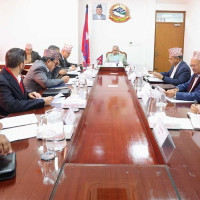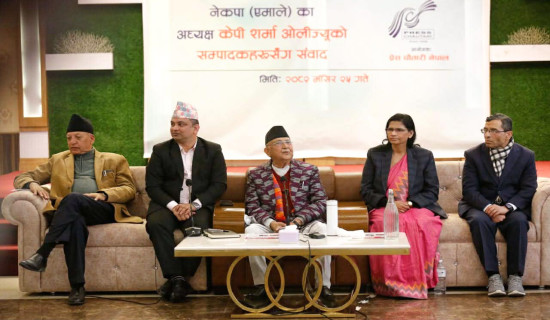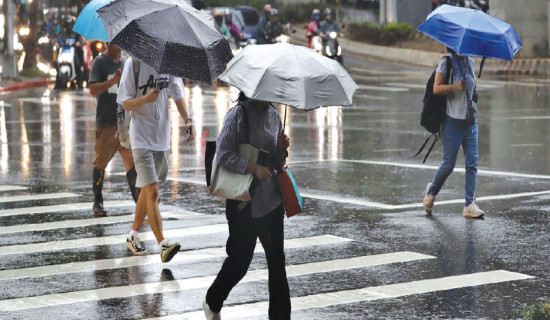- Thursday, 11 December 2025
Earthquake Memorial Day today
10 years after Gorkha earthquake, Nepal still at risk of seismic incidents
Kathmandu, Apr. 25: As the country marks the 10th anniversary of the 2015 earthquake on Friday, the fading memory of the disaster has become an issue of concern.
The 7.8 magnitude earthquake on April 25, 2015, killed nearly 9,000 people, damaged about 900,000 houses and thousands of public infrastructures.
Despite its toll on human lives, properties, infrastructures and the national economy, the day seems to have been forgotten by both the public and policymakers. This is also evident in the reduced frequency of quake-awareness campaigns and ritualistic approach to mark the earthquake day on April 25 and January 15 (marking the great earthquake of 1934).
Experts said that this fading public memory is concerning because the country is always vulnerable to future seismic events, and it is yet to fully implement long-term preparedness measures.
Dr. Lok Bijaya Adhikari, Chief of the National Seismological Centre, Nepal, said that the country remains highly vulnerable to seismic events. As a mountainous region, the continuous northward movement of the Indian tectonic plate under the Eurasian plate puts the entire Himalayan region at a high seismic risk.
“Even though we are at a high risk of earthquake, people have forgotten the day and started constructing big buildings. Even the government failed to generate awareness among the people about the further disaster,” he added.
“The western region of Nepal has not experienced a major earthquake (first recorded) since 1505, while the eastern region last recorded a significant seismic event in 1255. Since then, there have been no major quakes in these areas, indicating a buildup of seismic energy that could be released at any time,” he said.
“Historically, major earthquakes have occurred every 100 to 200 years,” he said. He added that the geothermal energy stored beneath the surface could be released at anytime and anywhere, from east to west across the country.
“Earthquakes measuring between 4.8 and 5.0 are not powerful enough to cause significant damage. Their tremors are usually felt in the areas where seismic energy has accumulated.”
Since the devastating earthquake of April 25, 2015, Nepal has experienced a total of 829 aftershocks with a few new tremors. The most recent quakes occurred on April 4, 2025, with epicenters in Jajarkot and Darchula, measuring 5.5 and 5.2 on the Richter scale, respectively. Most of these new tremors have been recorded in the western regions of the country.
The National Earthquake Monitoring and Research Centre records only those tremors that measure above 2 or higher on the Richter scale. But there are many smaller quakes below this threshold that go unrecorded.
Experts said Nepal is in a high-risk zone for earthquakes because the Indian tectonic plate is slowly moving north and pushing against the Eurasian plate. This movement created the Himalayas, but it also builds up pressure underground. When that pressure suddenly releases, it causes earthquakes. Because of the ongoing movement, it accumulates stress and making the country, especially the Himalayan belt highly vulnerable to frequent devastating earthquakes.
In the simple terms, frequent earthquakes in Nepal reflect that energy remains trapped in both the eastern and western parts of the country, as well as at elevations of 100 to 150 meters above the Chure range, starting from Kathmandu, Adhikari said.
Amod Mani Dixit, President of National Society for Earthquake Technology (NSET) Nepal, said that poor infrastructure was the main reason for the damages in the 2015 earthquake. “What can save lives is building earthquake-resistant structures,” he stressed.
During the April 2015 earthquake, 99 per cent of the fatalities occurred inside houses, while only one per cent died outside due to falling trees or landslides. “We need to understand that it is not the earthquake that kills people, but the buildings and infrastructure,” he said.
He said the awareness programme reached only 34 districts. Such an awareness programme should reach across the country because no one knows which part of the country will be the epicenter for the next seismic event, he said. Structural Engineer Rabin Chaulagain said that buildings constructed after the 2015 earthquake following the National Building Code are safer than those built earlier without such standards. As a result, the risk from earthquakes has been reduced compared to before.
He added that while the Building Code has been fully implemented in the Kathmandu Valley, its implementation at the local level is only in progress.
According to Chaulagain, the 800,000 privately reconstructed houses are generally safe from earthquakes. Public buildings and structures, such as schools and hospitals, are also mostly safe, with only a few exceptions.
“The Building Code should be implemented across all 753 local levels, but it has not been fully enforced yet,” he said. “Houses that were built earlier-- some nearly 100 years old or more -- are not earthquake-resistant and remain highly vulnerable,” he said.
The April 2015 earthquake affected 1.5 million buildings and impacted 5.1 million people. A total of 914,950 beneficiaries have been recorded and 410,310 grievances (complaints or appeals) have been resolved.
















